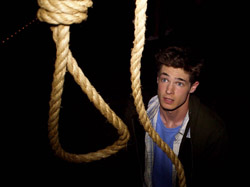 With one of the ’90s’ most iconic television series just a few months away from returning to the tube, now’s the time for The X-Files FAQ. (The jury, however, is still out for that subtitle: All That’s Left to Know About Global Conspiracy, Aliens, Lazarus Species, and Monsters of the Week — I mean, what the hell is a “Lazarus Species”?) John Kenneth Muir, who also penned 2013’s Horror Films FAQ for Applause’s ongoing pop-culture line of guides, has the unenviable job of distilling a decade-plus of content into a single trade paperback, yet rises to the challenge by refusing to do what the average reader might expect: give an episode guide. Although Muir does tackle many episodes, he tends to do so in thematic groupings while exploring what made The X-Files click (and sometimes not). Later chapters tackle the guest stars, the two movies, the official spin-offs, the countless knock-offs and, yep, even the porn parodies. The truth is in here.
With one of the ’90s’ most iconic television series just a few months away from returning to the tube, now’s the time for The X-Files FAQ. (The jury, however, is still out for that subtitle: All That’s Left to Know About Global Conspiracy, Aliens, Lazarus Species, and Monsters of the Week — I mean, what the hell is a “Lazarus Species”?) John Kenneth Muir, who also penned 2013’s Horror Films FAQ for Applause’s ongoing pop-culture line of guides, has the unenviable job of distilling a decade-plus of content into a single trade paperback, yet rises to the challenge by refusing to do what the average reader might expect: give an episode guide. Although Muir does tackle many episodes, he tends to do so in thematic groupings while exploring what made The X-Files click (and sometimes not). Later chapters tackle the guest stars, the two movies, the official spin-offs, the countless knock-offs and, yep, even the porn parodies. The truth is in here.
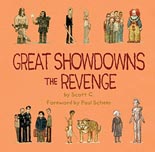 A sequel to 2013’s Great Showdowns: The Return (itself a follow-up to the previous year’s The Great Showdowns), Scott C.’s Great Showdowns: The Revenge features dozens upon dozens more of drawings of depicting some of pop culture’s greatest adversaries. That’s it: They just stand there facing one another, whether “they” are the characters of Fatal Attraction, Child’s Play, Road to Perdition — heck, even the Steve Coogan/Rob Brydon foodie comedy The Trip! And that’s fine, because Campbell — that’s what the C stands for — is a wonderful illustrator; his drawings radiate with immeasurable charm, even when they’re of some of the most evil A-holes the screen has seen. But not everything is decipherable, and there are no words, no captions, no legend at the end to let you know who was who. Not knowing can be frustrating, even if the unknowns number few. To be technical, not everything is a showdown, either. I’d hardly call Jiro dreaming of sushi anything approaching conflict.
A sequel to 2013’s Great Showdowns: The Return (itself a follow-up to the previous year’s The Great Showdowns), Scott C.’s Great Showdowns: The Revenge features dozens upon dozens more of drawings of depicting some of pop culture’s greatest adversaries. That’s it: They just stand there facing one another, whether “they” are the characters of Fatal Attraction, Child’s Play, Road to Perdition — heck, even the Steve Coogan/Rob Brydon foodie comedy The Trip! And that’s fine, because Campbell — that’s what the C stands for — is a wonderful illustrator; his drawings radiate with immeasurable charm, even when they’re of some of the most evil A-holes the screen has seen. But not everything is decipherable, and there are no words, no captions, no legend at the end to let you know who was who. Not knowing can be frustrating, even if the unknowns number few. To be technical, not everything is a showdown, either. I’d hardly call Jiro dreaming of sushi anything approaching conflict.
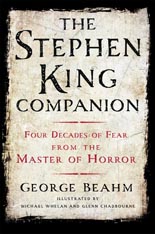 Given that its subject is alive, kicking and ridiculously prolific, the St. Martin’s Press trade-paperback release of The Stephen King Companion: Four Decades of Fear from the Master of Horror marks the third edition of George Beahm’s work, and he’s clearly in danger of busting through the page count of what publishing technology currently allows; as is, it stands at a mighty 624. Although it bears some resemblance to Hans-Åke Lilja’s 2010 brick from Cemetery Dance, Beahm’s is far better written and better packaged, thereby transcending what could have been merely a reference title to pluck off the shelf only if Google failed you. Instead, Beahm’s book can be consumed as an actual narrative or in pieces; it works both ways. Supplemented with a wealth of essays, interviews, sidebars, photos, Glenn Chadbourne’s illustrations and a gorgeous, full-color section of Michael Whelan’s paintings, this Companion resides in a netherworld of not quite a proper biography and not exactly a trivia collection, yet it should satisfy King’s fans looking for either or both. No stone in King’s career path — books, movies, van accidents — appears to have been left unturned.
Given that its subject is alive, kicking and ridiculously prolific, the St. Martin’s Press trade-paperback release of The Stephen King Companion: Four Decades of Fear from the Master of Horror marks the third edition of George Beahm’s work, and he’s clearly in danger of busting through the page count of what publishing technology currently allows; as is, it stands at a mighty 624. Although it bears some resemblance to Hans-Åke Lilja’s 2010 brick from Cemetery Dance, Beahm’s is far better written and better packaged, thereby transcending what could have been merely a reference title to pluck off the shelf only if Google failed you. Instead, Beahm’s book can be consumed as an actual narrative or in pieces; it works both ways. Supplemented with a wealth of essays, interviews, sidebars, photos, Glenn Chadbourne’s illustrations and a gorgeous, full-color section of Michael Whelan’s paintings, this Companion resides in a netherworld of not quite a proper biography and not exactly a trivia collection, yet it should satisfy King’s fans looking for either or both. No stone in King’s career path — books, movies, van accidents — appears to have been left unturned.
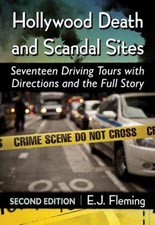 From title alone, your first instinct is to make fun of something like Hollywood Death and Scandal Sites: Seventeen Driving Tours with Directions and the Full Story — Second Edition. Then you realize that, dammit, author E.J. Fleming has done so much research and homework that snark turns to respect. Although the 17 of the title doesn’t sound like a lot of stops, note that those are “tours” — a term Fleming doesn’t take lightly. Arranged between district groupings like Sunset Strip, Brentwood and The Palisades are some 650 sites! The generally curious and the downright morbid can maneuver their way through Fleming’s succinct and exacting instructions, fully fleshed out with the historic, tragic details about the site in question, be it a home in which a celebrity expired or a spot marking one’s murder. From superstars and up-and-comers to everyone I could think of (Rebecca Schaeffer? Dominique Dunne?), they’re all here. It’s not quite as macabre as you’d think it to be; sorry if that disappoints you. —Rod Lott
From title alone, your first instinct is to make fun of something like Hollywood Death and Scandal Sites: Seventeen Driving Tours with Directions and the Full Story — Second Edition. Then you realize that, dammit, author E.J. Fleming has done so much research and homework that snark turns to respect. Although the 17 of the title doesn’t sound like a lot of stops, note that those are “tours” — a term Fleming doesn’t take lightly. Arranged between district groupings like Sunset Strip, Brentwood and The Palisades are some 650 sites! The generally curious and the downright morbid can maneuver their way through Fleming’s succinct and exacting instructions, fully fleshed out with the historic, tragic details about the site in question, be it a home in which a celebrity expired or a spot marking one’s murder. From superstars and up-and-comers to everyone I could think of (Rebecca Schaeffer? Dominique Dunne?), they’re all here. It’s not quite as macabre as you’d think it to be; sorry if that disappoints you. —Rod Lott

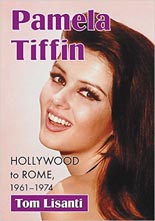
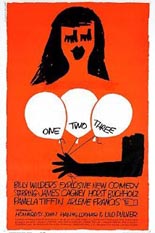
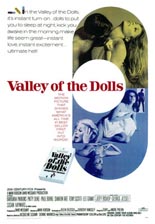
 As coined by Jacqueline Susann, the “dolls” of her 1966 breakthrough novel,
As coined by Jacqueline Susann, the “dolls” of her 1966 breakthrough novel, 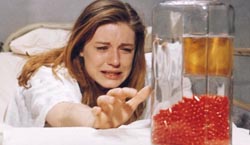

 Gary Jones’
Gary Jones’ 
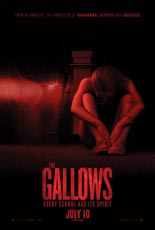
 Much curiosity surrounding
Much curiosity surrounding 